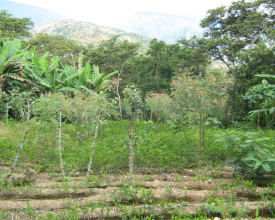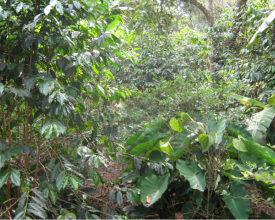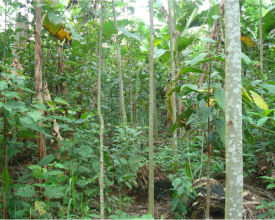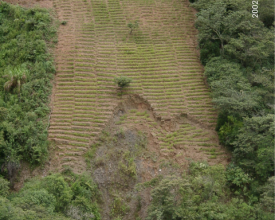
Successional Agroforestry between the Andes and the Amazon
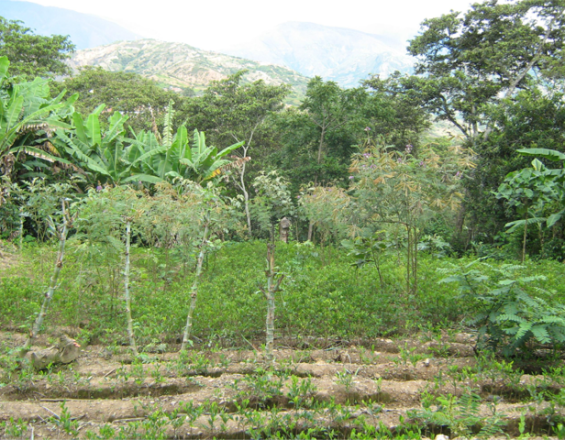
Human-nature interactions can only work in the long term if we respect and work with basic rules of life such as natural succession and biodiversity. Our experiences in successional agroforestry have shown that it is feasible to restore depleted soils and plantations of cacao, coffee or other crops in crisis without external inputs, by increasing the turnover of organic matter (energy), diversifying production systems, and adapting management practices to the specific requirements of the crop and the ecosystem. Simultaneously, the main problems with pests and diseases decline significantly. Visible results are achievable already in the short-term. At the same time, food security for farmers’ families improves. ECOTOP helps design alternatives and offers training in successional agroforestry, both in small and large scale farming systems.
Context
Challenges addressed
Bolivia has one of the highest deforestation rates of the world, and some of its biodiversity-richest ecosystems. Where the Andes connect with the Amazon, a challenge is to avoid extension of the agricultural frontier while preserving forests through integrative use. In the zone of the foothills of the Bolivian Andes where we work, called the Yungas, we see two different resource use visions: 1) migrants from the Andes who have been burning forests and implementing monocultures for around 60 years; and 2) local indigenous people (Mosetenes, Chimanes, Tacanas, Lecos, and others) who practice subsistence agriculture, complemented with hunting and gathering. The first have entered in a “fallow crisis” where soils are depleted, production is low, and attacks of pests and diseases increase the use of agrochemicals, many banned for their toxicity. Climate change increases the challenges through extreme weather events, prolonged droughts, and increased heat affecting working conditions.
Location
Process
Summary of the process
A profound in-depth conceptional and practical training is the fundament for upscaling. Thus the described farmer training program is closely linked to upscaling.
We have conceptual, methodological and practical tools for different ecosystems and situations, but our vision is not vertical teaching but a dialogue of wisdoms, starting from local knowledge and experiences. As there is no general recipe for SAFS (but underlying principles), we use the experience and vision of local “lighthouse” families in field courses, farmer-to farmer exchanges and academic research. Many of such trained lead farmers have become local leaders and are now promoting SAF locally. We work with different kinds of local actors: communities, their organizations (syndicates, cooperatives, small enterprises, women’s’ groups, local indigenous organizations), municipal governments, innovative families, given that there is a wish for change. The spiritual component is crucial: A relationship with nature needs to be re-established, people need a vision in the long term and invest in terms of costs, energy and risk. Of course there are also people who do not continue the transition to successional agroforestry.
Building Blocks
Farmer field schools
As there is no general recipe for SAFS (but principles), we use the experience and vision of local “lighthouse” families in field courses and farmer-to farmer exchanges. Concretely we accompany the restoration of degraded plots, and also the implementation of new ones, with a successional focus and without using fire.
During a 12 months modulized training with 8 modules of one week each, farmers a trained in dynamic agroforestry. 5 modules are centralized where the principles of dynamic agroforestry are taught in theory and practice. Between the centralized modules, the participants are implementing according to their specific farm conditions a dynamic agroforestry plantation on their own farm. ECOTOP trainers monitor and supervise them, visiting each participant on their farm. The implementation, costs, challenges, problems, development and success is recorded by each participant. During the last module as "final test" each participant presents his experiences with his garden and lessons learnt. One concept is to grant local innovative farmers a university title of agricultural technicians, which generates prestige in the communities and helps to interact with policy-makers. Many of such “peritos” have become local leaders and are now in various positions, promoting SAF locally.
Enabling factors
Rewarded local leaders educated in SAF with a university degree has helped to establish and to develop the vision in various local public and private entities. Especially women have profited increasing their decision-making role in the families, as they were often the first to try SAF with a view to satisfy food security, involving their children in the activities. Often husbands joined later on when seeing benefits in yields and household economy. Crucial of the success is a thorough selection of participants who are committed and open minded.
Lesson learned
Those farms that follow the logic of short-term (e.g. food, banana and hibiscus which has a stable market), medium (e.g. fruit trees, coffee, cacao, coca) and long-term (high-value timber) crops have been the most successful. Also, complementing a cash crop (e.g. cacao) with food crops that generates income throughout the year (e.g. banana) has shown to be a successful economic strategy. It is crucial to accompany the process closely from the beginning on. At least 3 on-farm field visits of each farmer with practical instructions is required during the first year. Follow up should be guaranteed during 3 to 5 years. A dynamic and participatory local institutional framework is essential.
-Obstacles are often institutional restrictions or lack of understanding of dynamics of nature, therefore, learning has to be considered as a process in the long term. Another main obstacle is an extractivist logic that has been promoted with the colonization of the Yungas and other tropical areas, an approach where nature and biodiversity are rather seen as threat than as virtue.
Upscaling of implementation of Dynamic Agroforestry Systems
The producer family with their garden is always linked with a broader sphere, such as the relationships between gender and generations, the social organisation, community, local and international markets, the cultures, and – something often overlooked as important – religion and/or spirituality. These aspects, however, should be considered within the concept of training.
The proposed methodology is based on a period of intensive theoretical and practical training of local trainers (facilitators) and lead farmers. In addition, the participants must "rebuild" their knowledge on their own plots of land. Individual practice must be supervised and accompanied by a senior trainer experienced in Dynamic Agroforestry.
Lead farmers present their practical know-how and document the processes experienced in the following installation period. In this way, a practical implementation of the concepts worked on can be achieved within a concrete context for the production level of a rural family.
Upscaling is achieved as followed:
- 1 local trained facilitator trains 10 lead farmers
- 10 lead farmers accompany 5 to 10 farmers each in implementing DAF
- 10 trainers accompany 100 lead farmers
- 100 lead farmers = 500 to 1000 followers
Enabling factors
- A long term concept of developing programs for at least 5 years
- Participitory institutional framework
- Commited and open-minded staff
- Budget for training, follow up, equipment, and monitoring
- Accurate selection of local trainers and lead farmers
- Practically skilled SAF senior trainers
- Access to market for cash crops
- Short term benefits for farmers (anual crops, less labour, no expenses for external inputs)
Lesson learned
The most important experience is the benefit of land preparation without fire. The advantage of SAF can be seen already after a couple of months, which helps to encourage farmers to extend learning plots step by step to the whole plantation. Short-term economic needs foster monocultures with expensive external inputs, creating more short-term economic needs. Also, agriculture is not a desirable future for many, and the young migrate to cities (generational conflict). National mega-projects such as dams threaten local initiatives. Other adverse conditions are unfulfilled basic needs, bad infrastructure and extreme climate conditions that impede dedication to long-term SAFS initiatives. However, we note an increasing awareness of the importance to preserve trees and biodiversity, and interest in SAF because of the need to restore soil fertility, and because families see that those who implement the mode are being less affected by climate change impacts, have better working conditions, healthier and more diverse food, and better markets (e.g. for organic cacao, coffee, coconut or coca).
Impacts
Successional agroforestry systems (SAFS, also “dynamic agroforestry systems”) feature multi-purpose and natural regeneration trees and many crops, based on natural succession dynamics: Crops and trees are grouped as pioneers, secondary or primary species, depending on their life cycle, to form a composition in which all stories (spatial) and all phases (temporal) are occupied, maximizing density and diversity. Where cacao is the main crop, a SAFS can start with maize and rice in combination with manioc and pigeon pea, followed by banana and papaya, pineapple and Inga sp., providing shade for slowly growing primary forest species such as cacao, fruit trees, mahogany, and palm trees. Timber as a long-term investment dominates the system after 10–15 years, with cacao in full production. Farmers harvest pioneer species from the first year on. The high diversity provides environmental services like soil regeneration, organic matter accumulation, improved microclimate, and pest control. Management is knowledge intensive, requiring regular pruning and selective weeding. The advantage of SAFS can be seen already after a couple of months which helps to encourage farmers to extend learning plots step by step to the whole plantation. . The most important experience is the benefit of land preparation without fire.
Beneficiaries
Farmer families in the Yungas region (Alto Beni and South/North Yungas), cocoa and coca farmers.
Ecuador: 800 farmers are renovating unproductive cocoa plantations
Ghana: Pilot phase to work with 800 cocoa farmers
Samoa: Pilot phase cocoa palm farmers
